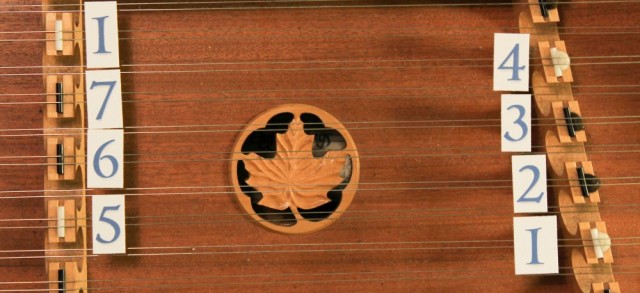Please don’t be dismayed by the possibility that this blog post is going to get too technical! The concepts are simple, and I think they are incredibly useful!
When I got my first hammered dulcimer in 1988, I decided I would set a standard for myself for how I would approach the notes I was going to play. The dulcimer came with note-name strips that could be temporarily taped onto the sound board next to the bridges so I could learn where the notes were to be found; I decided not to put those on, though, because… I concluded that I didn’t want to think about what the notes were!
Really? Yes, really! I wanted to break free of the idea of thinking specific notes, but rather to think of the structural patterns of the music as it moved on this particular instrument.
There’s certainly nothing wrong, of course, in thinking that the note you play next is, say, a G --- in itself. But in order to consider the overall arch of the piece of music, I find it more useful (and freeing) to think of moving from location to location physically. And, to me, that is actually closer to the music theory that is involved than the letter names are, because the scale is such a clear and recognizable thing on a hammered dulcimer: the scale is a series of seven notes operating in the shape of a box, and that happens the same way in each of the keys’ boxes, regardless of letter names involved.
So we can think of any given note on the hammered dulcimer (or on any instrument, in one way or another, as associated with how that instrument works) in three particular ways.
- The letter name. The C scale, for example, has seven exact and particular pitches: C, D, E, F, G, A, B; then it starts over in the next octave. But if you go to a different key, you’ll have to start all over in naming the scale steps to match those new pitch locations.
- Scale steps as numbers. The scale in any key is known in this system as a set of numbers from 1 to 7. The scale, then, is 1, 2, 3, 4, 5, 6, 7; then the new octave carries the same numbers on up again. No letters need to be involved in one’s thinking, because the first scale step is always 1, no matter what key you’re in. American music theorists employ this approach a lot in talking about steps, intervals, chords, etc., because the idea is clear without having to name a particular pitch. A scale is a scale is a scale, and that’s what music is made out of!
- Physical locations on the instrument. The next system is what I tend to use as I play hammered dulcimer (or flute or mountain dulcimer or whistle, according to each instrument’s design features): The scale becomes a set of locations in a clear shape; as I said earlier, on the dulcimer it’s a box. It ascends the scale from the lower right marked course up through two unmarked courses to the next marked course, then repeats that series directly to the left, forming a pattern that encompasses a box shape. It’s the same pattern no matter which marked course you begin on.
Within that framework, chords are seen to be a triangular shape, and two-note intervals show themselves to be one angle or another between the spots where the hammers hit the strings. Harmonies often become determined by an intuition for those triangles and angles. But this is not just vague intuition: It’s an intuitive understanding that the physical box shape provides a definite setting for these geometric things to be found in; and with only seven different notes, it’s a delightfully limited area to work within! Forget the ‘noodling’ idea --- or on the other extreme, forget the memorization of note letters! One’s kinesthetic memory can kick in, and it’s a wonderfully liberating feeling to sense the clear logic of that experience of bodily movement.
I use all three of these methods of note identification, depending on the needs of a particular context. But as I play the instrument itself, I find that I gain the most truly living music from that third, physical, involvement with the scale.
I encourage you to develop this in your own playing!





Comments